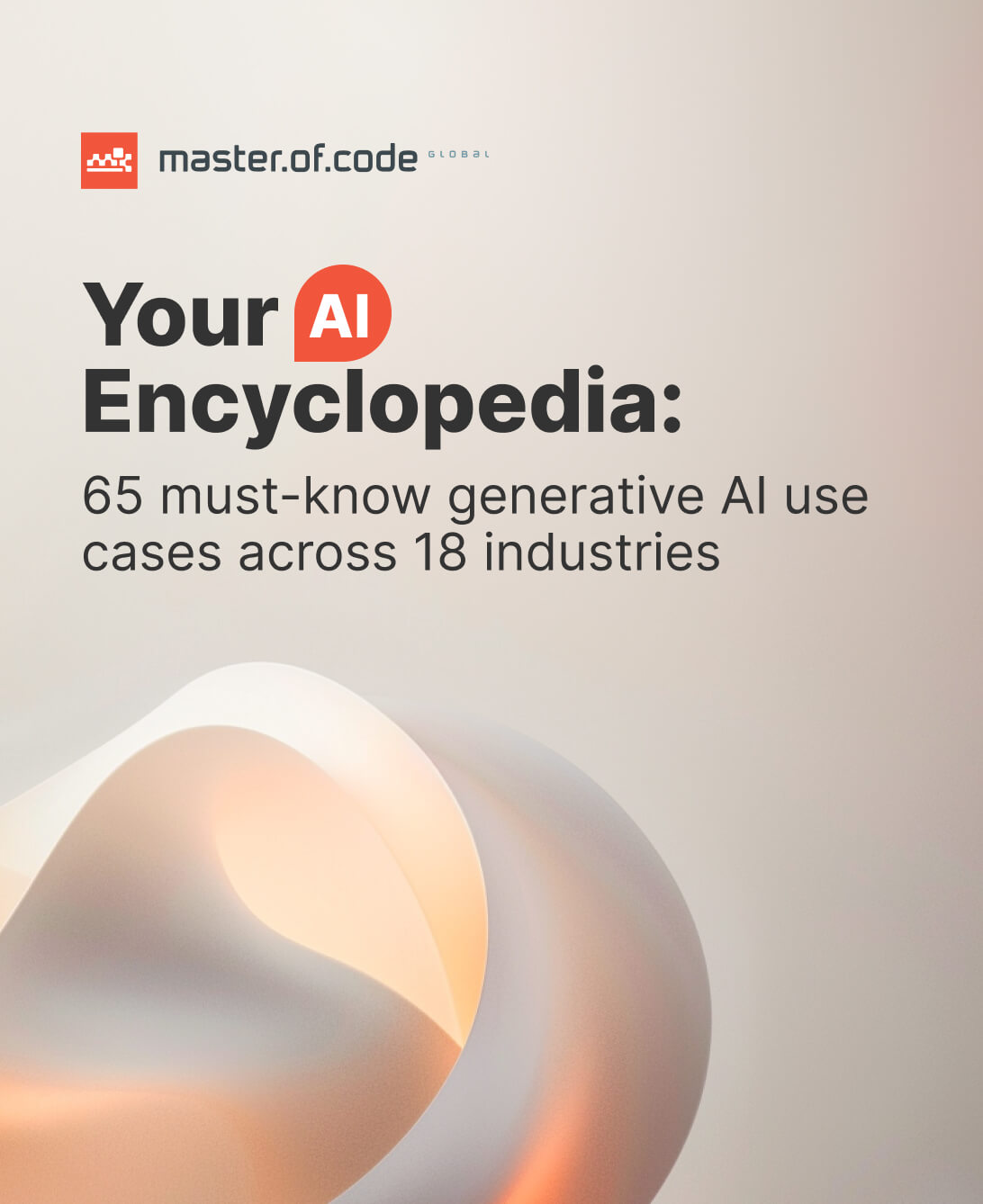After years of architecting solutions for telecom giants like T-Mobile and Go Inc., we know what delivers real impact and what doesn’t. What we see now is that AI in telecommunications has become a standard practice, not a temporary experiment. The debate about whether it can deliver is over. We’re in the era of scaled deployment and measurable returns.
A clear example? In a recent engagement, we implemented a virtual assistant for a Tier-1 telecom provider. It handled over 1.1 million customer interactions, achieved a 73% containment rate in the Netflix experience, and maintained a 45% self-service success rate for one-time payments and AutoPay – significantly reducing pressure on live agents while improving response speed and satisfaction. This wasn’t a lucky outlier; it’s what happens when AI is aligned with business-critical KPIs and rolled out with strategic intent.
If you’re facing rising churn, shrinking margins, and mounting operational costs, AI in telecom isn’t just another tech line on your balance sheet. It’s working capital, unlocked. It’s your call center finally scaling with demand. Finally, it’s real-time insights that let you act before clients leave, not after.

This article is a practical, C-suite playbook for deploying high-impact artificial intelligence across customer support, retention, and revenue operations. Let’s break down what’s working, where to start, and how to build for long-term ROI.
Table of Contents
The Data-Driven Urgency for AI in Telecom
While dramatic cost reduction is compelling on its own, understanding the underlying market forces makes the case for AI in telecommunications indisputable. What follows is a data-driven look at the three core pressures that make artificial intelligence a present-day necessity, not a future luxury.
The Data Deluge is an Operational Reality
The scale of growth in mobile network traffic is staggering. In Q2 2025, global mobile data traffic reached ~180 exabytes (EB) per month, up about 19% year-over-year. Ericsson projects that by 2030, it will more than double, hitting nearly 280 exabytes per month without even counting Fixed Wireless Access. When FWA is included, the monthly total could rise to ~430 EB. Meanwhile, 5G’s share of global mobile data traffic rose from ~26% in 2023 to 35%, with projections pushing that share past 80% by 2030.
Managing this much information manually – predicting network faults, optimizing Quality of Service (QoS), balancing load in real time – is no longer feasible. Machine learning is the only tool capable of optimizing network behavior at scale, identifying patterns, automating responses to anomalies, and proactively ensuring performance.
The Mandate of the Connected Customer
Clients today expect more – and telecoms are being held to a much higher standard. A Salesforce “State of the Connected Customer” report shows that ~80% of users say that the experience a company provides is as important as its products or services. Additionally, lackluster personalization, delays, or impersonal approach are no longer tolerable – they’re major drivers of churn. Digital channel responsiveness, seamless omnichannel support, and instant, context-aware interaction became baseline expectations.
The Unavoidable Economics of Support
Helpdesk operations are under extreme margin pressure. Gartner and others predict that by 2026, Conversational AI deployments in contact centers will reduce agent labor costs globally by USD 80 billion. Self-service and digital interactions cost a fraction of live agent calls: routine questions automated via virtual agents or chatbots reduce handling time, training expenses, attrition costs, and overhead.
For many telecom operators, moving a portion of Tier-1 support to digital self-service creates substantial savings. Those funds can be redirected into innovation, network upgrades, or better customer experiences. It also frees live agents to handle cases that truly need human judgment.
Practical AI Use Cases in Telecom
All these pressures are opportunities for targeted intervention. Now that we’ve quantified the need, let’s explore the specific AI use cases in telecom that address these issues head-on across the three core pillars of your business.
Customer Experience
Client loyalty is the most critical metric you can move. These tools are not going to replace humans, but create frictionless, high-value experiences that reduce churn and build lifetime value.
- AI Customer Service and Support Automation
Streamlining routine tasks with virtual assistants, chatbots, or voice AI can free human agents from repetitive work, enabling faster response times, fewer escalations, and higher satisfaction. - Generative AI
Innovative technologies (e.g., large language models) can summarize conversations, draft responses for agents, or even compose self-service knowledge articles in real time. That helps reduce agent handling times and improves consistency. For example, McKinsey reports that Generative AI has helped telcos reduce service costs by 15–20% in early deployments. - Chatbots and Voice AI
24/7, multilingual, context-aware bots let clients get answers outside business hours. Voice intelligence can route calls, predict caller intent, and escalate only when necessary, cutting wait times and mis-routes. These tools, collectively part of Conversational AI in telecom, enable telcos to scale high-quality service without scaling headcount. - Proactive Customer Engagement
Instead of waiting for complaints, use artificial intelligence to detect at-risk users based on usage, billing, or support behavior. Reach out with personalized offers, resolve issues before they explode, and keep relationships strong. - AI-Powered Search
Many customers abandon service because finding help feels like looking for a needle in a haystack. With natural language understanding, smart search makes FAQs and instruction docs easy to use. People get answers faster, and agents handle fewer requests.
Operations and Infrastructure
Client experience is what your users see; operational excellence is what makes everything else possible and profitable. These real-world applications show how AI in telecom industry operations drives resilience, efficiency, and security.
- Predictive Analytics for Network Maintenance
Digital systems can monitor hundreds of sensors across network equipment, detect early signs of hardware failure or congestion, and schedule maintenance proactively, avoiding downtime and expensive reactive fixes. - AI for Field Service Management
Optimize scheduling, routing, and parts logistics for field engineers with digital tools. Fewer travel hours, fewer delays, and better first-time fix rates all contribute to lower cost and higher consistency. - AI in Telco Cyber Security
With network complexity and attack surfaces rising (IoT, 5G, edge computing), artificial intelligence is essential to detect anomalies, respond to threats, and offer data integrity. Tools that learn normal behavior and flag deviations help stop fraud, breaches, and leakages before they cost you. - AI in Billing and Transaction Support
Disputes and errors are major sources of churn and wasted resources. Advanced algorithms can automatically verify usage, detect anomalies (e.g., overcharges or fraudulent usage), even generate accurate invoices, reducing controversies and increasing trust. - Dynamic Network Policy with AI
Use digital tools to adapt policies in real-time: e.g., shifting bandwidth between services based on demand, dynamically reallocating resources in congested cells, or optimizing QoS across different classes of customers. This maximizes infrastructure utilization and cost efficiency.
Growth and Revenue
Once cost and loyalty are stabilized, growth becomes the next frontier. In this section, we shift focus: beyond saving money, AI in telecommunication becomes a generator of new revenue – turning data, insights, and innovation into money in the bank.
- AI Monetization Models
Build new products with artificial intelligence – like enterprise analytics, APIs for aggregated network data, or add-on subscription services for telecom customers. - AI-Driven Revenue and Marketing
Use digital tools to power Customer Value Management (CVM): segment consumers more precisely, automate campaign execution, optimize offer timing. - True Personalization in the Telecom Industry
Beyond generic bundles, use AI to tailor service plans, recommend add-ons, or dynamically price offerings based on usage, customer profile, predicted lifetime value. The difference in client stickiness and incremental revenue from effective personalization can be profound. - RCS and Conversational Commerce
Rich Communication Services plus conversational interfaces (chat, voice) offer a channel for upselling and cross-selling: customers can interact via messaging, receive unique offers, make transactions or service upgrades without leaving the system. It’s a growth lever that blends user experience and conversational commerce in telecom, helping operators move from simple providers to digital experience leaders.
How to Build Your AI Telecom Strategy
By now, the value of AI in telecommunications is clear – and the list of use cases is long. But that abundance can also create hesitation. With so many opportunities, where do you start? Which path drives the greatest impact? How do you get results, not just experimentation?
This section is your antidote to complexity. Below is a focused, four-step framework designed for telecom leaders to prioritize effectively, launch fast, and scale with confidence. These steps provide the foundation for a strategy that delivers measurable ROI from day one.
Define the Business Goal
Start with the “why.” What specific KPI do you need to move?
Is your priority to reduce churn by 10%? Increase ARPU in your prepaid segment? Cut contact center costs by 30%? Without a clear goal, AI initiatives risk becoming science projects – interesting, but unimpactful.
Set a target that’s measurable and aligned with your current pain points. This becomes your north star – guiding solution selection, measuring success, and aligning stakeholders from marketing to operations to IT.
Audit Your Data Foundation
Artificial intelligence doesn’t run on code – it runs on data. Before deploying any solution, audit your current landscape. Are customer interactions centralized? Is network telemetry data accessible? Do you have labeled datasets for training digital models?
This step is where external expertise pays off. A specialized partner offering AI consulting for telecom can help assess your infrastructure, map data pipelines, and bridge technical gaps with actionable recommendations.
Launch a High-Impact Pilot
Don’t try to transform everything at once. Start small – smart.
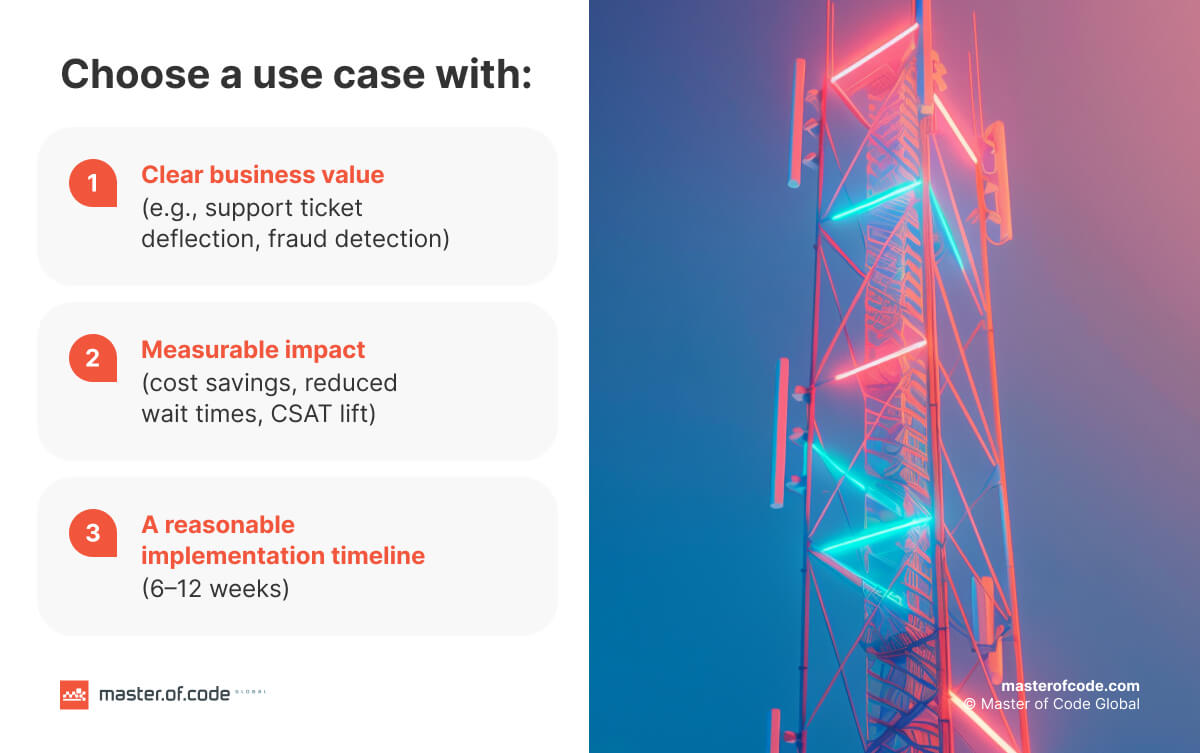
One common starting point is deploying a GenAI-powered support chatbot to deflect Tier 1 inquiries. These pilots often show ROI within the first 60 days. And perhaps more importantly, they build internal credibility, surface integration requirements, and act as a model for larger rollouts.
Select the Right Technology Partner
Framing this as an IT project undersells it; what’s at stake is a company-wide transformation with direct impact on growth and profitability.
The right partner brings industry fluency – an understanding of telecom’s regulatory complexity, legacy infrastructure, customer lifecycle, and cost structures. They know what KPIs matter and how to move them.
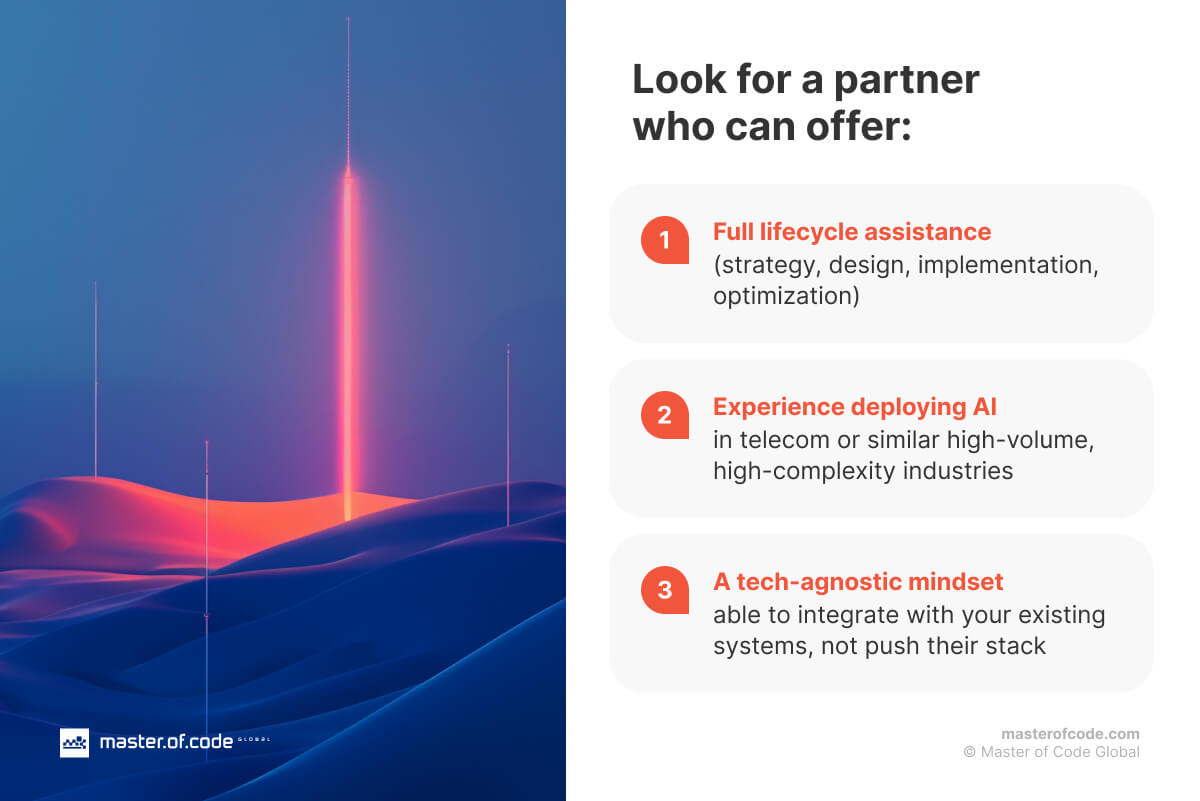
At Master of Code Global, we specialize in tailoring digital strategies to telecom’s specific realities – balancing speed with scale, innovation with integration.
Our Work in AI for Telecom: Real-World Results
A strategy is only as good as its execution. And execution is where most AI in telecom initiatives either take flight or fall flat. That’s why choosing the right partner is critical. Here’s a look at how Master Of Code Global put our principles into practice to drive measurable business value for our clients.
Case Study #1: Gen AI-Powered Network Troubleshooting Solution

Challenge:
A leading telecom provider faced the challenge of transforming their network troubleshooting process from a time-consuming, manual procedure into an efficient, intelligent system. With growing customer expectations for quick resolutions, the company needed a solution that would enhance agent performance, streamline diagnostics, and improve the overall troubleshooting process.
Solution:
Master of Code Global developed a Gen AI-powered assistant designed to work seamlessly within existing messaging channels. This intelligent solution enabled human agents to deploy AI assistance with a single click during live interactions. The AI agent was built to adapt dynamically to customer inputs, providing tailored troubleshooting solutions in real-time. We created adaptive dialogue flows that responded contextually to each customer’s unique situation and integrated AI insights directly into agent dashboards. Additionally, we provided all-in-one performance analytics, enabling the telecom provider to track key efficiency metrics.
Results:
- +25% more network issues resolved without needing escalation to specialists.
- -18% less time spent per case as agents receive organized, real-time information.
- +10 NPS points, resulting in happier customers who feel heard and get their problems solved without the runaround.
This solution transformed the way the telecom provider approached troubleshooting, improving both operational efficiency and customer satisfaction through smart automation and seamless integration.
Case Study #1: AI Audit for GO Malta
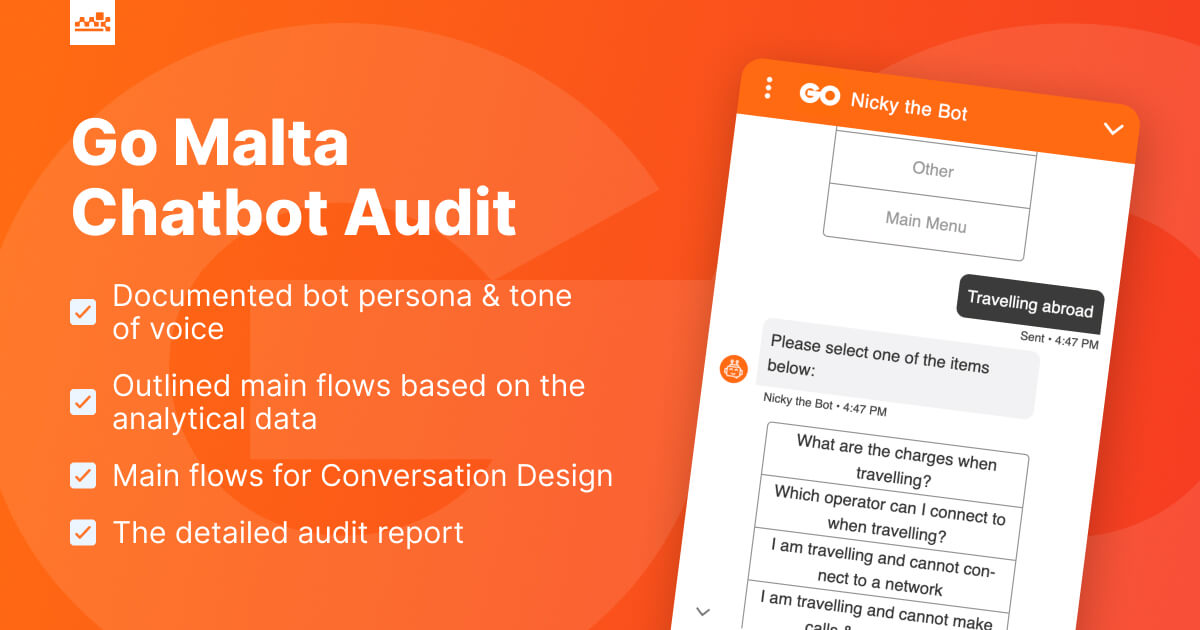
Challenge:
GO Malta, the island’s leading telecommunications provider, wanted to transform its existing chatbot into a high-performing, customer-centric engagement tool. However, the bot struggled with inconsistent responses, limited personalization, and a rigid conversational structure – issues that directly impacted user satisfaction and resolution efficiency. With growing expectations and a vision for GenAI integration on the horizon, GO Malta required a clear, strategic blueprint to evolve their bot into a scalable, intelligent support tool.
Solution:
Master of Code Global conducted a comprehensive chatbot audit, blending technical evaluation with conversation design expertise. Our team analyzed thousands of user transcripts, mapped the end-to-end client journey, stress-tested NLP capabilities, and reviewed the bot’s backend integration and error handling performance.
We applied our proprietary Bot Analysis Framework to score performance, uncover friction points, and benchmark against industry best practices. In parallel, we ran conversation design workshops to realign the bot’s tone, structure, and user experience with GO Malta’s brand and customer expectations. Special emphasis was placed on preparing the architecture for future GenAI integration, making sure the next phase of evolution could be implemented without architectural rework.
As a result, we:
- Delivered a detailed audit report with actionable recommendations across technical performance, NLP optimization, and client experience design
- Developed a documented bot persona and tone of voice, along with fully mapped and refined conversation flows
- Provided a clear roadmap for GenAI enablement, future-proofing the chatbot for advanced automation and unique engagement
- Identified and prioritized improvements to increase containment, reduce escalation, and streamline customer journeys across key use cases
This project laid the foundation for a next-generation support experience, turning GO Malta’s bot into a scalable, resilient, and future-ready digital assistant that aligns with the company’s broader digital strategy.
Case Study #2: Top Telecom Virtual Assistant
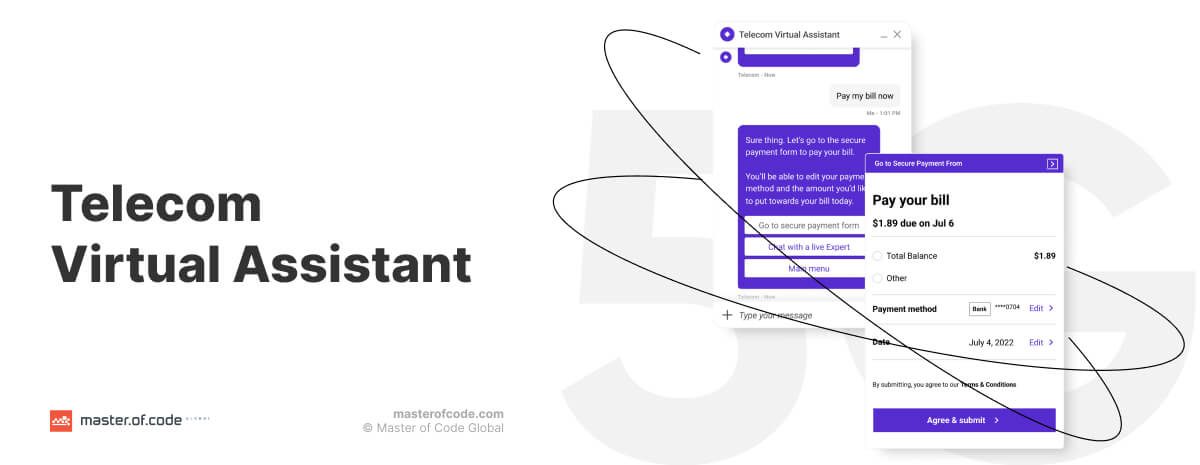
Challenge:
As America’s largest and fastest 5G provider, this telecom brand – known as the country’s “Un-carrier” – serves over 315 million people nationwide. When the COVID-19 pandemic hit, the company faced an unprecedented surge in requests. Clients endured long wait times to reach live experts via phone or chat, driving frustration and threatening customer satisfaction scores. Leadership recognized the need for a scalable, automated service channel to deliver faster self-help options, reduce pressure on human agents, and improve CSAT and NPS. The challenge: how to leverage AI and ML to reimagine digital engagement across every touchpoint.
Solution:
The brand partnered with Master of Code Global to augment their internal Digital AI team. Together, we launched a web and in-app conversational assistant designed to deliver empathetic, user-centric experiences across 40+ use cases – from FAQs to complex, transactional workflows. Our role included:
- Strategic roadmapping and use case prioritization to align automation with business goals
- Conversation design services to refine flows, tone, and persona for maximum engagement
- Bot tuning and NLU optimization using real customer data to improve accuracy and intent coverage
- Conversational AI consulting to expand capabilities and prepare for future scalability
Over time, the virtual assistant evolved to handle sophisticated transactions such as making one-time payments, managing mobile services, upgrading devices, adding lines, and setting up AutoPay. It was fully integrated with backend APIs, allowing authenticated, end-to-end self-help while enabling seamless escalation to live Experts when needed.
We delivered the following results:
- Engaged with 1.1M+ customer conversations
- Delivered a 45% containment rate in one-time payment and AutoPay flows
- Achieved 73% containment in the Netflix experience
- Reached 64% containment in Paramount Plus support journeys
- Drove 62% containment in Device Protection use cases
- Significantly reduced wait times, freeing live Experts to focus on complex issues while improving user satisfaction
This collaboration redefined digital engagement for the brand. By combining Conversational AI expertise with strategic execution, the telecom leader created a scalable assistant that not only absorbed millions of interactions but also delivered measurable business impact across multiple customer journeys.
The Two Timelines for Telecom’s Future
Looking at the market today, we see two distinct horizons unfolding for telecom operators. Each is shaped not by technology alone, but by the strategic decisions leaders make right now.
Timeline A: The Reactive Path
This is the path of incrementalism. It’s defined by short-term fixes and deferred transformation. Operators on this path spend resources patching legacy systems, offering short-lived discounts to stem churn, and reacting to customer frustrations after the fact. AI exists, but only in silos – never integrated, never scaled. Meanwhile, support costs climb, margins compress, and innovation lags behind more agile competitors. This is a future of constant pressure and operational drag – a game of survival, not growth.
Timeline B: The Intelligent Path
This path is different. It’s proactive. Strategic. Here, AI isn’t an experiment; it’s embedded in the core of the business. Networks predict and self-optimize. Customer support is instant, personalized, and always on. Product and marketing teams use real-time insights to launch precisely targeted campaigns. Data is not a byproduct, but the engine for new revenue streams, smarter operations, and differentiated services.
Operators on this path reduce churn not with relevance – they shift from firefighting to forecasting. Instead of merely defending margin, they turn it into a growth engine.
The technology to build Timeline B is not hypothetical. It’s mature. It’s tested. It’s already delivering results for operators who’ve made the strategic choice to lead.
The only variable is leadership.
Your company’s future will be defined by which timeline you build.
If you’re ready to explore what Timeline B looks like for your organization, let’s talk.
Schedule a no-obligation AI strategy call with our telecom experts – and together, we’ll map the fastest path to sustainable growth, operational resilience, and customer loyalty built for the next decade.


